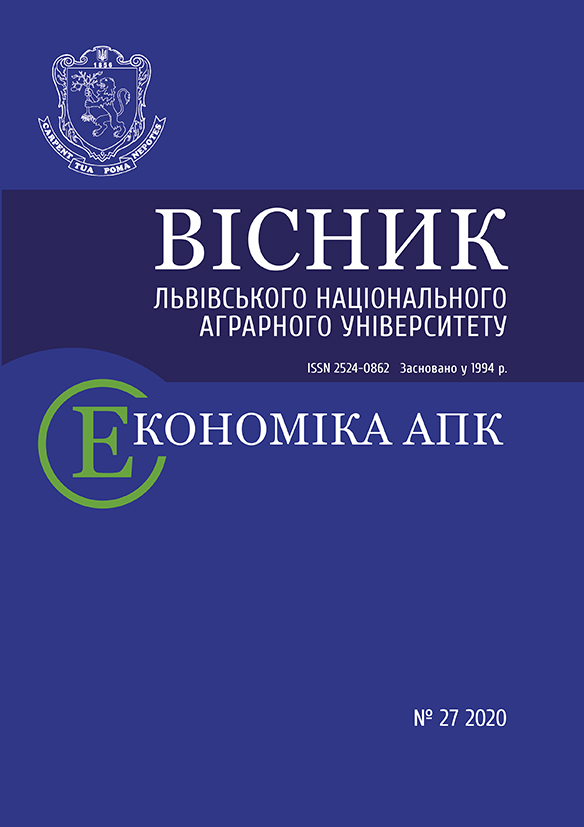Visnyk LNAU: Agronomy 2020 №24: 117-122
Seed and residue yields and nutritional value of selected broad bean varieties
J. Franczuk, Dr.Sc.
ORCID ID: 0000-0002-8440-850X
R. Rosa Dr.Sc.
ORCID ID: 0000-0001-6344-538X
Myslinska M., M. Sc.
ORCID ID: 0000-0001-6249-741X
Slonecka D., M. Sc.
ORCID ID:0000-0002-8696-2774
Hajko L., M. Sc.
ORCID ID: 0000-0001-5293-8402
Siedlce University of Natural Sciences and Humanities
Dydiv O., Cand. Sc.
ORCID ID: 0000-0003-4155-5945
Lviv National Agrarian University
https://doi.org/10.31734/agronomy2020.01.117
Annotation
Broad beans are an excellent vegetable source of protein, carbohydrates, essential minerals, vitamins and antioxidants, dietary fibre, and other health-promoting compounds. Beans are recommended for use in case of diseases of the circulatory system. It also regulates the activity of the digestive system – thanks to fiber, it significantly speeds up the process of metabolism, so it is readily used in diets. Vegetative residues after harvest are used in animal husbandry, as it is an excellent feed to increase milk yield and weight. For poultry, the above-ground bean mass is dried, ground and added to the mixes.
In Poland, this vegetable is gaining more and more popularity. The yield of broad beans grown for an early harvest is determined by many factors, and among others, the selection of the right cultivar is particularly important.
The field experiment was carried out in Central Eastern Poland, at the Agricultural Experimental Station in Zawady, on luvisol soil. The purpose of the research was to compare the yield and nutritional value of three broad bean varieties: ‘Windsor Bialy’, ‘Bizon’, and ‘Bachus’, and the amounts of their postharvest residues. The experiment was founded in a split-block design with three replications. Broad bean plants were harvested at the milk stage of the seeds. After the harvest, the yields of pods and seeds were determined. The biological performance of the crop was calculated on the basis of the seed weight to pod weight ratio. Additionally, the length and width of the seeds and their thickness at the hilum were measured. In broad bean seeds, the content of dry matter, L-ascorbic acid, total sugars, protein, calcium, and phosphorus were determined. After the harvest, the yield of the residues of broad bean plants was calculated.
Taking into account the biological performance of the crop varieties, it was found that due to its yield ‘Bizon’ should be recommended in the climatic conditions of Central Eastern Europe. The ‘Bizon’ cultivar also contained the highest total sugar and phosphorus content. Among the varieties, ‘Windsor bialy’ produced the highest amount of stalks, which would be a rich source of nitrogen for plants grown after broad bean.
Key words
Vicia faba L. var. major, cultivar, yielding, nutritive value, postharvest residues
Link
- European Union. 2009. Commission Regulation NO 152/2009. Off. J. Eur. Union L54:1–130
- FAOSTAT 2020. Broad bean and horse bean production in 2018, Crops/Regions/World list/Production Quantity (pick lists). UN Food and Agriculture Organization, Corporate Statistical Database. Retrieved 10 March 2020.
- Grela E. R., Makaruk J., Czech A., Panayiotou P. P. 2003. Wartość odżywcza i dietetyczna nasion nowych odmian bobu (Vicia faba var. major) [Nutritive and dietary value of new sorts of broad bean seeds (Vicia faba var. major]. Żywienie Człowieka i Metabolizm. 3-4: 919–924.
- Jabłońska-Ceglarek R., Franczuk J., Zaniewicz-Bajkowska A., Rosa R. 2002. The effect of summer catch crops on yielding and chosen elements of nutritious value of onion and red beet. Folia Horticulturae. 14(2): 11–23.
- Jadczak D., Grzeszczuk M., Rekowska E. 2005. The estimation of yielding of new broad bean cultivars in the cultivation for green seeds. Zeszyty Naukowe AR we Wrocławiu. 515: 217–221.
- Jensen E. S., Peoples M. B., Hauggaard-Nielsen H. 2010. Faba bean in cropping systems. Field Crops Research. 115: 203–216. https://doi.org/10.1016/j.fcr.2009.10.008
- Kulig B., Szafrański W., Zając T. 2004. Yielding of catch crop cultivated after field bean and organic carbon contents in the soil dependent on weather conditions. Acta Agrophysica. 3(2): 307–315.
- Kulka K., Grzesiuk S. 1978. Białka nasion roślin strączkowych. Roczniki Nauk Rolniczych. 1(166): 53–90.
- Łabuda H. 2012. Flowering and characteristics of useful traits of some faba bean (Vicia faba L. var. major Harz) cultivars and breeding lines. Acta Agrobotanica. 65(4), 2012: 139–148. doi.org/10.5586/aa.2012.031.
- Ntatsi G., Gutiérrez-Cortines M.E., Karapanosa I., Barros A., Weiss J., Balliu A., Santos Rosa E.A., Savvasa D. 2018. The quality of leguminous vegetables as influenced by preharvest factors. Scientia Horticulturae. 232: 191–205. https://doi.org/10.1016/j.scienta.2017.12.058
- PN-A-04019 1998. Food products – Determination of vitamin C content. – Produkty spożywcze – Oznaczanie zawartości witaminy C [in Polish].
- Rekowska E. 2007. The influence of flat covers and methods of clove planting on yielding of Garlic cultivated for bunching harvest. Roczniki AR w Poznaniu, CCCLXXXIII, Ogrodnictwo. 41: 589–593.
- Singh A. K., Bharati R. C., Manibhushan N. C., Pedpati A. 2013. An assessment of faba bean (Vicia faba L.) current status and future prospect. African Journal of Agricultural Research. 8: 6634–6641. doi. 10.5897/AJAR2013.7335.
- Stagnari F., Maggio A., Galieni A., Pisante M. 2017. Multiple benefits of legumes for agriculture sustainability: an overview. Chemical and Biological Technologies in Agriculture. 4:2. https://doi.org/10.1186/s40538-016-0085-1
- Suso M. J., Moreno M. T., Mondragao-Rodrigues F., Cubero J. I. 1996. Reproductive biology of Vicia faba: role of pollination conditions. Field Crops Research. 46: 81–91. https://doi.org/10.1016/0378-4290(95)00089-5
- World Reference Base for Soil Resources 2014. 2015. World Soil Resource Reports FAO 106, Rome.



